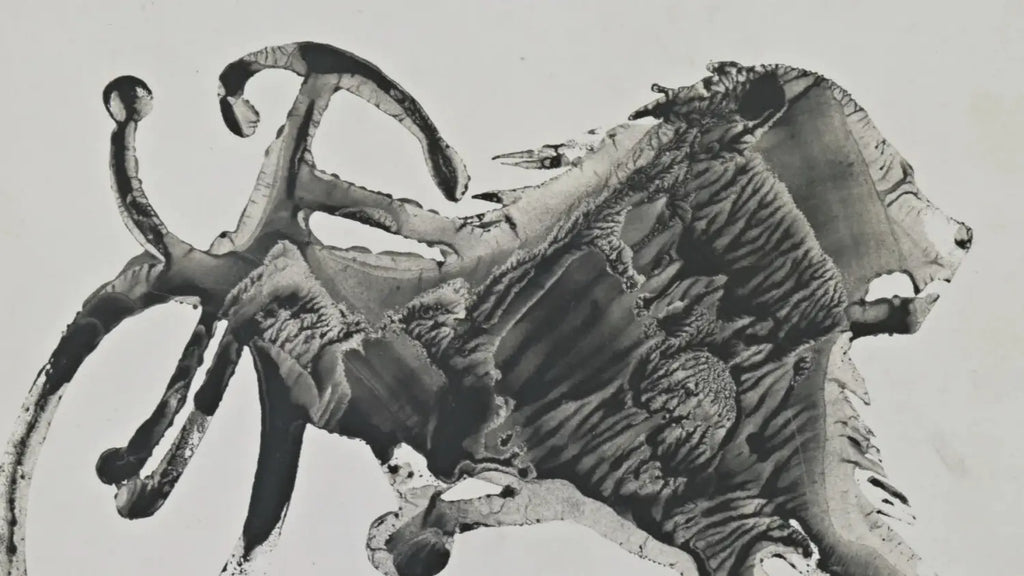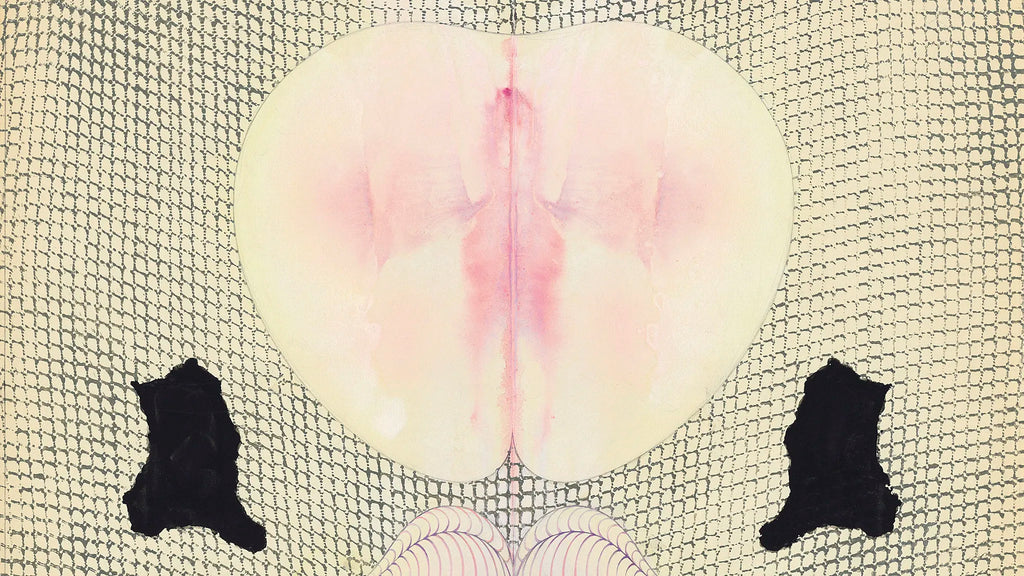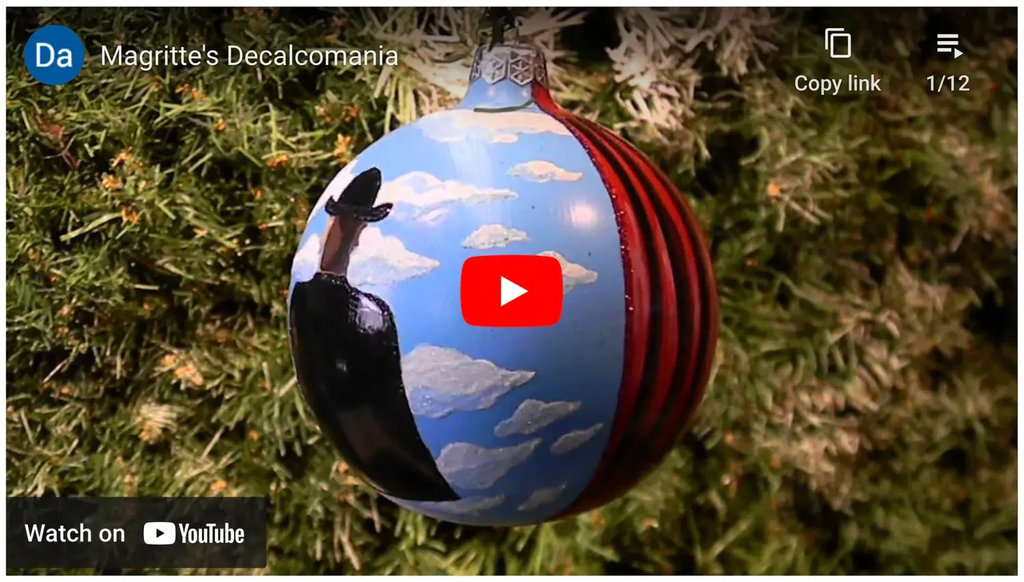要約、異世界、およびオーガニック:デカルコマニアアートの乱雑な魔法
Decalcomaniaは、2つの表面の間に濡れた塗料またはインクを押してから分離してユニークでオーガニックなデザインを明らかにすることにより、抽象的なパターンを作成するシュールなテクニックです。この方法は、20世紀初頭にオスカー・ドミンゲスを介してテクニックを開拓したドイツの芸術家であるマックス・エルンストによって普及しました。
この記事では、DeCalcomaniaの歴史、シュールレアリスムのアーティストがどのように使用したか、独自のDeCalcomania Artを作成するための段階的な指示、DeCalcomania Artの最も有名な作品のいくつかのショーケースを探ります。
Decalcomaniaの歴史
Decalcomaniaは、彫刻や版画を陶器や他の材料に移すことができる装飾技術です。この手法は、1750年頃にイギリスで最初に商業的に使用され、米国に輸入されました 少なくとも1865年には。その発明は、フランスの彫刻家であるサイモン・フランソワ・ラベネットに起因しており、後にイギリスに移り、彼がそれを呼んだプロセスを完成させました。デカルカー".
このプロセスには、インク、塗料、または別の培地を表面に塗布し、濡れている間、紙、ガラス、アルミホイルなどの材料で覆うことが含まれます。削除すると、 材料はパターンを転送します それはさらに装飾されるかもしれません。 Decalcomaniaの最も一般的な例には含まれます 紙に塗料を塗布してから折ります、圧力をかけ、次に紙を展開して鏡パターンを明らかにします。
ファインアートでの使用に加えて、Decalcomaniaは、「デカール」として知られる大量生産コモディティアート転送や製品ラベルなどの商用アプリケーションで使用されています。 Vitrifiable Decalcomaniaは、装飾や碑文をセラミック、ガラス、板金、鋳造金属、または望んでいるその他の材料に装飾や碑文を伝達するために使用されるデカルマニアの一種です。 印象を備えています.
シュールレアリスムアートのデカールコマニア
このテクニックは、Surshrealistsによって採用され、意識的なコントロールではなく偶然に画像を作成しました。シュールレアリスムのÓscarDomínguezは、彼の作品を「先入観のないオブジェクトのないDecalcomania」と呼んでいました。彼は1936年にテクニックを取り上げ、紙または他の表面に薄く広がるガッシュを使用して(ガラスが使用されています)、それがキャンバスなどの別の表面に押されます。ドミンゲスは黒のガッシュを使用しましたが、後に色が登場しました。ドイツのアーティストであるマックス・アーンストは、ハンス・ベルマーとレメディオス・ヴァロと同様に、デカールコマニアも実践していました。 Salvador Daliも手を出しました。以下を参照してください。
このテクニックにより、アーティストは、表現と現実の伝統的な概念に挑戦した抽象的で異世界の風景と生き物を作成することができました。結果として得られる画像は、しばしば風景、有機的な形、または抽象的な形状に似ています。 偶然と自発性に大きく依存しています.
Decalcomaniaで見つかった異世界または夢のようなパターンは、シュールレアリストの目的に適しています。エルンストのようなアーティストは、洞窟、木、岩の形成を明らかにする転送効果を活用します。
の色、形、マーク 抽象芸術 アーティストが感情、アイデア、経験を伝えることができる革新的な視覚言語を提供します。
アートワークのテーマにあまり焦点を当てていないため、抽象的な芸術が作成されたプロセスと資料は、はるかに重要性を高めています。テクスチャー、深さ、特に色は、アーティストの意図を伝える重要なツールになります。
独自のデカールコマニアアートを作成します
独自のデカールコマニアアートを作成することは、最小限の素材を必要とする楽しくて簡単なプロセスです。これが段階的なガイドです...
- 作業面を準備することから始めます。 濡れた塗料から保護するために、プラスチックまたはワックス紙の層で覆います。
- 塗料を選択してください。 アクリル塗料はこの技術に適していますが、他の種類の塗料を試すことができます。
- 塗料の層を1つの表面に塗布します。 ペイントブラシまたはパレットナイフを使用してペイントを適用できます。層はパターンを作成するのに十分な厚さであることを確認しますが、乾燥に時間がかかるほど厚すぎないように注意してください。
- 別の面を塗装面に押し付けます。 紙、キャンバス、さらには葉っぱや布などの別のオブジェクトを使用することもできます。
- しっかりと押し下げてください そして上面を持ち上げると、ペイントによって作成されたパターンが現れます。
- プロセスを繰り返す 最終結果に満足するまで、さまざまな色や表面を試してください。
デカルコマニアの注目すべきアートワーク
デカルコマニアは、美術史上最も複雑で畏敬の念を抱かせる芸術作品のいくつかを作成するために使用されてきました。以下に、有名なデカルコマニアのアートワークの例をいくつか示します。
マックス・エルンスト作「花嫁の衣装」

アーティスト
マックス・エルンスト (1891-1976) はドイツの画家兼彫刻家で、芸術における不合理性の主要な提唱者の 1 人であり、シュルレアリスムのオートマティズム運動の創始者でした。
アートワーク
花嫁の衣装は一例です エルンストの真実主義的または幻想的なシュルレアリスム、伝統的な手法が、違和感や不安を引き起こす主題に適用されます。
この絵には、赤い羽根を広げながら、非常に分厚い素材を組み合わせたような手の込んだ衣装を着た花嫁が描かれています。中央のシーンは、その対応するシーンと対比されます。 絵の中の絵 左上にあります。花嫁が同じポーズで現れ、彼女自身もその一部である古典的な廃墟の生い茂った風景の中を闊歩しているところ...
花嫁の服装 この作品は 1940 年に完成しました。その時点で、芸術家は芸術の世界で著名な地位を確立し、想像力を自由に探索することができました。
ルネ・マグリットのデカルコマニー

アーティスト
ルネ・マグリット (1898-1967) は、機知に富んだ示唆に富んだイメージで知られるベルギーのシュルレアリスム芸術家で、しばしば 見慣れたオブジェクトを珍しい状況で見る.
アートワーク
「Décalcomanie」は、変容と隠蔽の概念を探求しています。 この絵画は、外界におけるアーティストの存在と内なる世界におけるアーティストの存在を対比させることによって、目に見えないものを明らかにしようとしています。
この絵には曇り空を背景に立つ人物が描かれているが、キャンバスの別の部分にはカーテンで隠されていた雲が現れている。この並置は曖昧な感覚を生み出し、見る者に、見えるものと隠れたもの、現実と想像上のものとの関係に疑問を抱かせるようにします。 の ネガティブスペースの使用 男性の輪郭を表現すると、見る人は画像の両側に焦点を合わせて同じものを見ることができます。
デカルコマニアでは、濡れたペイントまたはインクを 2 つの表面の間に押し付けて、抽象的なパターンを作成します。しかし、この特定の作品では、マグリットは伝統的な技法を使用しているようには見えず、むしろデカルコマニアの概念をうぬぼれとして使用し、私たちの実存のコインの表裏として機能する変容と隠蔽のアイデアをもてあそんでいます。
オスカー・ドミンゲスの無題

アーティスト
オスカル・ドミンゲス (1906-1957) は、次の作品で知られるスペインのシュルレアリスム画家でした。 ゆるく描かれたシュルレアリスム絵画。彼はそれに専念した 若い頃絵を描く 成長に影響を及ぼし、顔の骨と手足に進行性の変形を引き起こす重篤な病気を患った後です。 ドミンゲスは、デカルコマニーという自動人形技術の先駆けとなりました。
アートワーク
ドミンゲスは自分の作品を「先入観のないデカルコママニア彼は最初は紙やガラスにガッシュを使用していましたが、その後、 キャンバスに押し込む.
「無題」では、ドミンゲスはデカルコマニーを巧みに使って流動性と動きの感覚を呼び起こしています。これ ガッシュを紙に転写すると、自然に浮かび上がるような有機的な形やパターンが生まれました。 ドミンゲスは、デカルコマニアを戦術的に使用して、動いているライオンのたてがみのテクスチャーの動きを作成しました。アーティストは、驚くべき構成を利用して夢のような構図を構築しました。狩りをするライオンの流れるような動きの中で、現実と想像の境界が曖昧になる場所。
サルバドール・ダリのデカルコママニア

アーティスト
サルバドール・ダリ (1904-1989) は、その技術的スキル、正確な製図技術、そして 印象的で奇妙な画像 彼の作品の中で。
アートワーク
「デカルコマニア」は1936年にサルバドール・ダリによって制作されました。 この作品 骨格が特徴です を持つ女性 花の頭というモチーフ。 目立っていた ダリの作品の中で この期間に. この絵はナイーブ アート (原始主義) スタイルで、前景にデカルコマニーのアーチ型の風景が描かれています。この風景は、神秘と陰謀の感覚を呼び起こす、複雑なクモの巣状のパターンで構成されています。謎めいた骸骨を中心としたこの絵は、デカルコマニー技法の生の多用途性を示しています。その意味は、生と死に関するあらゆる種類の解釈に広く開かれています。
ハンス・ベルマー著『サン・タイター』

...
結論
デカルコマニアは魅力的で予測不可能です シュールレアリスムの技法 それは何十年にもわたってアーティストにインスピレーションを与えてきました。この方法によって作成された有機的で抽象的なパターンは、表現と現実に関する伝統的な概念に挑戦し、芸術家が神秘と陰謀の感覚を呼び起こす別世界の風景や生き物を作成できるようにします。
熟練したアーティストであっても、初心者であっても、デカルコマニアは楽しくて簡単に試しられるテクニックです。いくつかの基本的な材料と実験意欲があれば、あなたの創造性とビジョンを反映した、独自の予測不可能なパターンを作成できます。
—




